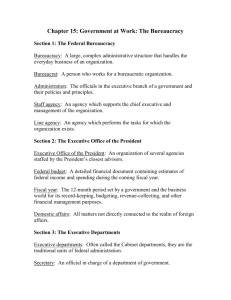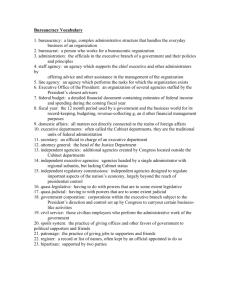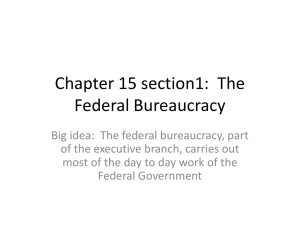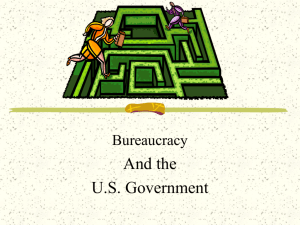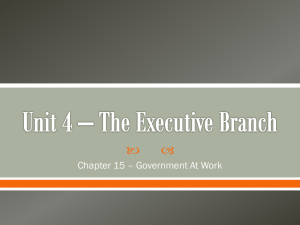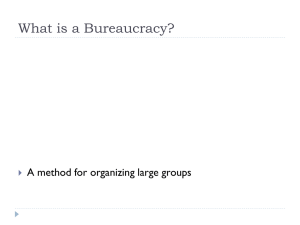Cabinet Departments
advertisement
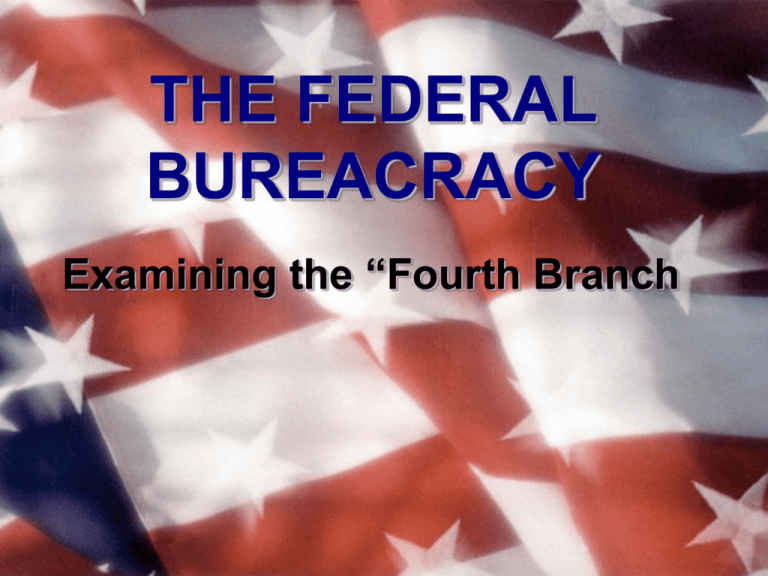
THE FEDERAL BUREACRACY Examining the “Fourth Branch Bureaucracy Definition: an administrative system, especially in a government, that divides work into specific categories carried out by special departments of non - elected officials Characteristics of a Bureaucracy • administration of government through departments • consists of unelected often highly trained professionals • task specialization • hierarchical authority Public Perceptions of Bureaucracies • impersonal • inclined to follow rigid or complex procedures • may stifle effectiveness and innovation • “red tape” The Federal Bureaucracy is: 4 million employees; 2.8 million are civilians or “civil servants” President only appoints 3% (patronage or political appointments) 15 cabinet level departments 200+ independent agencies with 2,000+ bureaus, divisions, branches, etc. Biggest - Dept. of Defense, U.S. Postal Service, Veterans Administration Functions of the Federal Bureaucracy 1. 2. 3. Implementation - carry out laws of Congress, executive orders of the President Administration - routine administrative work; provide services (ex: SSA sends social security checks to beneficiaries) Regulation - issue rules and regulations that impact the public (ex: EPA sets clean air standards) The Federal Bureaucracy Consists of 1. Cabinet Departments 2. Independent Executive Agencies 3. Independent Regulatory Commissions 4. Government Corporations Federal Bureaucracy Congres s President Executive Office of the President (Ex: OMB, NSC) Cabinet Departments (Ex: State, Defense) Independent Executive Agencies (Ex: CIA, NASA) Government Corporations (Ex: Amtrack, Postal Service) Independent Regulatory Commissions (Ex: FCC, SEC) The Cabinet Departments • The 15 cabinet departments headed by a cabinet secretary appointed by the president and approved by the Senate • Each department “expert” in specific policy area • Each department has its own budget • Department of Homeland Security, created in 2002, is newest department Executive Secretary Department of Homeland Security Commandant of Coast Guard (1) Legislative Affairs Secretary Inspector General ---------------------------------- Public Affairs Deputy Secretary General Counsel State and Local Coordination Special Assistant to the Secretary (private sector) National Capital Region Coordination Citizenship & Immigration Service Ombudsman (1) Chief of Staff Director, Bureau of Citizenship & Immigration Services (1) Small & Disadvantaged Business Director of the Secret Service (1) Privacy Officer International Affairs Shared Services Under Secretary Management Civil Rights and Civil Liberties Counter Narcotics Under Secretary Science and Technology Under Secretary Information Analysis and Infrastructure Protection Under Secretary Border & Transportation Security Under Secretary Emergency Preparedness and Response Independent Executive Agencies • Established by Congress with separate status outside the executive branch • Given a specific mandate and generally perform a service function, not a regulatory one. • Some examples include: Social Security Administration, CIA, NASA, EPA. Independent Regulatory Commissions • IRCs exist to regulate a specific economic activity or interest such as the Federal Communications Commission (public air waves) or Federal Reserve Board (banking system, money supply) • IRCs operate independently from Congress and the President • Once appointed and seated, members cannot be removed without cause Government Corporations • Government owned businesses created by Congress • May or may not be profitable, but serve a public need • Ex: U.S. Postal Service, Amtrak, Tennessee Valley Authority, Corporation for Public Broadcasting Who are the “Bureaucrats?” • • • • 97% are career government employees Only 10% live in the D.C. area 30% work for the D.O.D. Less than 15% work for social welfare agencies • Most are white collar workers: secretaries, clerks, lawyers, inspectors & engineers • Civil employees more diverse demographically than Congress The President supervises the Bureaucracy The President can: • appoint & remove agency heads • reorganize the bureaucracy • issue executive orders • reduce an agency's budget Congress Oversees the Bureaucracy Congress can: • create or abolish agencies & departments • cut or reduce funding • investigate agency activities • hold committee hearings • pass legislation that alters agency's functions an Former FEMA Chief Michael Brown testifies before House committee investigating Hurricane Katrina • influence or even fail to confirm presidential appointments Federal Courts Check the Bureaucracy Federal courts can: • through judicial review rule on whether the bureaucracy has acted within the law and the U.S. Constitution • provide due process for individuals affected by a bureaucratic action Supreme Court of the United States
